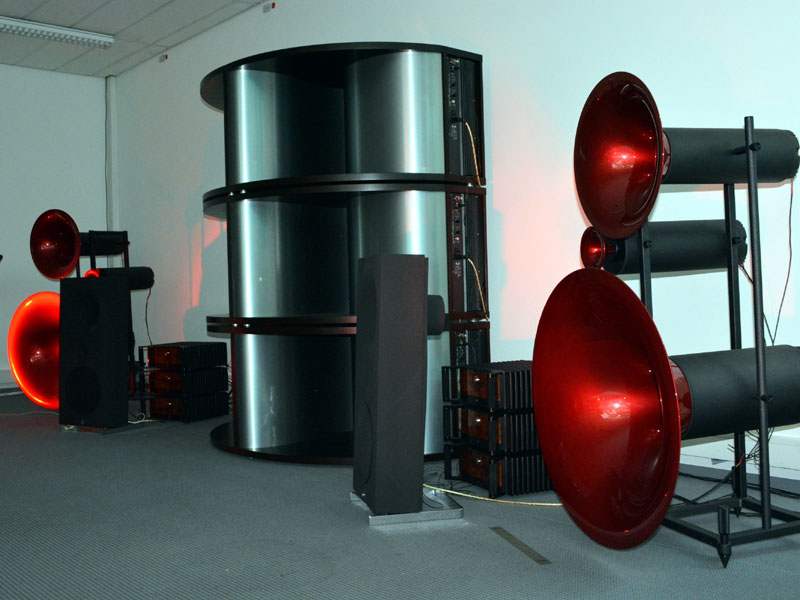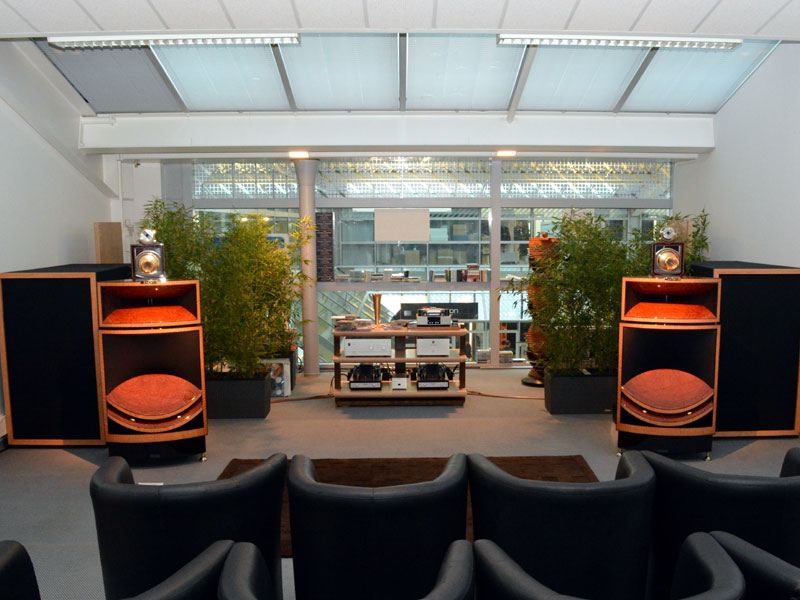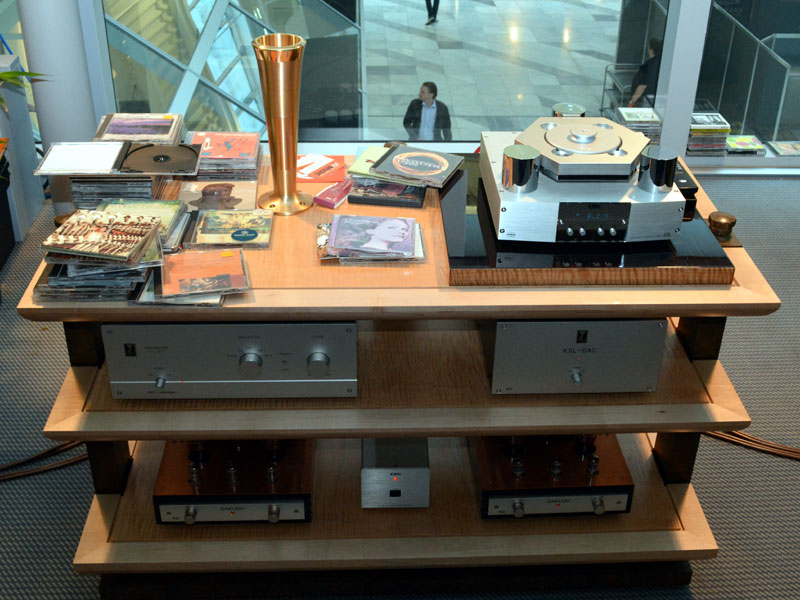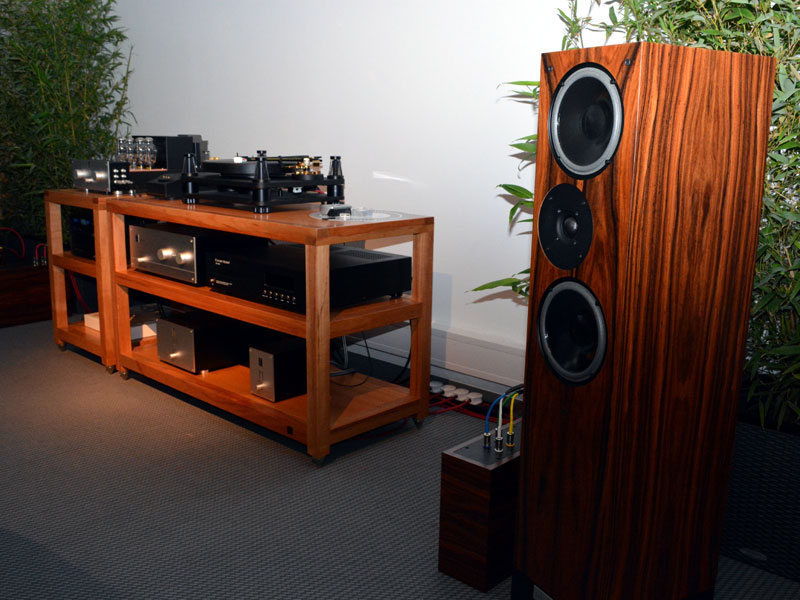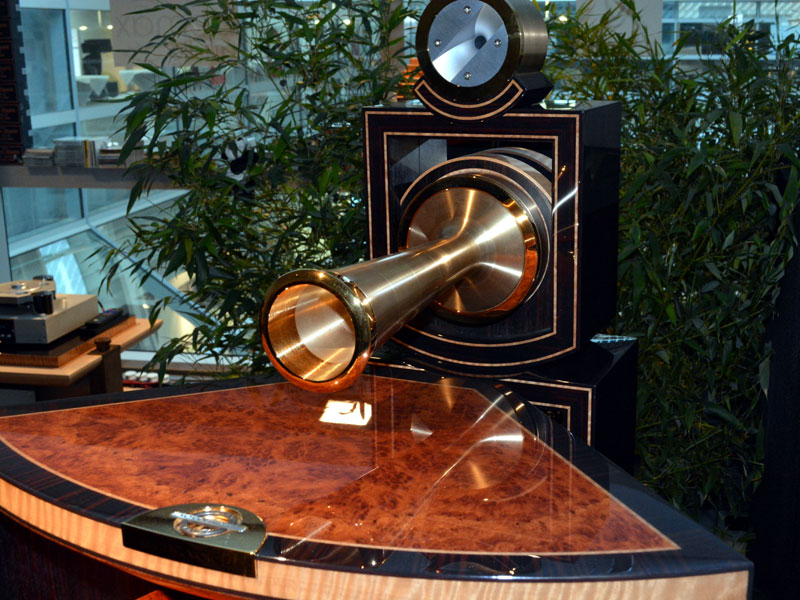High End 2013 • The Show Within the Show
ay in Munich might not have quite the same ring as April in Paris, but it’s a date I always look forward to with some anticipation. Ever since the High End Society migrated from Frankfurt to the MOC convention center, the nature and focus of the event have changed, but its importance continues to grow. With UK shows (and the industry that supports them) in hiatus, and the Italian and Greek economies in turmoil, Munich is unquestionably the premier high-end-audio event in Europe, the halls and corridors of the show packed with all that is good and great -- or wants to be -- in the serious audio world. Make no mistake, this is all about two-channel and for once the "high end" label is fully deserved. You will see multichannel and A/V presentations, but they are few and far between and generally just as ambitious as the two-channel setups. With its open atria, multiple cafes and eating options, large rooms and bright, light, airy spaces, there really is no better place to see and talk about old friends and new products.
But there’s the rub. I never returned from Frankfurt without having heard at least two truly ear-bending and perspective-altering systems, sonic and musical experiences that left an indelible mark on the consciousness. The very qualities that make Munich the best place to view hi-fi equipment also make it a challenging environment in which to present its sonic virtues; and good sound isn’t just hard to find, it’s rarer than a clean copy of the Stones’ first album. Indeed, it’s almost as if exhibitors have thrown in the towel, with many of the most interesting products being shown on static display. The trends are still there to be seen -- “source+” systems from the likes of Avantgarde and Focal -- but it was also noticeable how often small systems offered a more impressive view of the music than their bigger stablemates: Avantgarde’s impressive and innovative Zero 1 setup and Lindemann’s neat and compact Musicbook-series electronics both spring to mind. In some respects, the Munich show has, through no fault of its own, become a window onto the failings of the industry as a whole. Presented with a sonically difficult environment, it is simply not enough to shrug your shoulders and say, “Well, it’s only a show.” We seem to have forgotten that high-end audio isn’t about the price or presentation of the product but about its performance. "High end" is about ambition and attitude, and if manufacturers or distributors cannot impress under these conditions, why should the public believe they’ll do any better in their homes? Some companies do impress, and that throws a worrying light on the others -- because year in, year out the presentations that succeed are the ones for which the proper attention to the fundamentals of system setup have been paid, the very things we are all supposed to embrace and enact without question. There can be no better illustration of that point than the Living Voice room, a presentation that involved not just the most expensive system on show, but by far the most ambitious and musically impressive too. But what made it even more impressive still was the realization that, for a tiny, bespoke manufacturer like Living Voice, the cost and logistical impact of just attending the Munich show, let alone bringing its largest and most complex system, represents either a gigantic leap of faith or a massive gamble. How refreshing that Kevin and Lynn Scott have the skills, commitment and self-confidence to rise to the challenge and do so in such triumphant style. As you can tell, I was seriously impressed -- and there was plenty to be impressed by!
So what exactly awaited the unwary visitor who wandered unsuspecting into the Living Voice domain? Well, you could hardly miss the huge, hugely expensive and sumptuously veneered Vox Olympian speakers. These four-way, multi-cell horn "satellites" (Kevin Scott’s brutally frank description of a speaker that possesses barely more bandwidth than an LS3/5a) start at £255,000 a pair and go up from there, depending on finish and materials employed. The show pair tipped the financial scales at a mere £450,000, making for some very fancy woodwork and detailing indeed. But where there are satellites, surely there must be subs. Indeed so -- and those huge, black, fabric-wrapped cabinets looming behind the Vox Olympians are a pair of prototype Vox Elysian horn-loaded subwoofer cabinets, each with a pair of 13" drivers and a solid-state amp and hybrid active crossover to drive them. An asking price that starts at £180,000 dovetails nicely with the fiscal impact of owning the main speakers.
Now, you might be thinking that it’s all downhill from there -- at least in cost terms -- but you’d be wrong about that. Take the rack as an example. Possible to mistake for a finite-elemente Master Reference, it is in fact Living Voice’s own G8 design, incorporating a pre-loadable, three-axis suspension system derived from aerospace engineering and built onto a 250kg (550-pound) cast-bronze spine. Developed specifically for installing a customer’s system aboard his super yacht, it is designed to support 100kg of equipment at accelerations of up to 8G -- hence the name -- allowing you to listen to Ella while rounding Cape Horn. It retails for a mere £40,000 and in this instance supported a full suite of Kondo (Japan) electronics. A CEC TLOX CD transport (£17,500) fed a Kondo KSL DAC (£34,000), Kondo M77 line stage (£34,000) and a pair of Kondo Gakuoh push-pull 300B monoblocks (£58,000). The power amps were fitted with Western Electric tubes, just to ensure that there can be no accusations of scrimping or cutting corners. The whole system was wired with Kondo silver cable, including power cords and internal wiring on both the electronics and speakers, mirroring the level of system coherence that so impressed me while reviewing the Crystal Cable/Siltech setup.
But the really sobering thought is that those Kondo prices have tumbled recently, due to currency fluctuations and the value of the Yen. Even so, the wrong side of £140,000 (or over $200,000) -- plus cables, and they’re not cheap -- for the electronics in a single-source system is still eye-wateringly expensive. But Living Voice weren’t finished yet. Lurking in a rear corner of the room was what looked uncannily like a stack of ammunition boxes, although it was actually a Living Voice Pure Music battery supply, an 800A-per-hour reservoir, complete with high-quality phase inverter, capable of running the entire system without help from Munich’s mains supply, other than to charge the batteries when required. At £14,000, all that peace of mind seems like a veritable bargain when you’ve already invested in the rest of the system.
Before I get to the sound, it is perhaps only fair to point out that Living Voice also cater to those whose accommodation is insufficiently commodious to entertain a pair of Vox Olympians, and whose bank account is not quite that commodious either. Their speaker line starts with the almost prosaically sensible Auditorium, a 93dB-sensitive d’Appolito two-way floorstander with an easy-to-drive impedance curve and equally easy-to-accept price tag of £3500/pair. Available in a range of different versions, featuring better drivers, crossover components and cabling, the OBX-RW (£9400 in Santos rosewood veneer) was driven by a more modest, albeit still extravagant system. Sources were an SME 20.3 turntable (£6500) carrying a Kondo-wired SME 5 tonearm (£3000) and Kondo IoM cartridge (£6400), or (now discontinued) Resolution Audio Opus 21 or Living Voice-modified Canary CD300 (£6500) CD players. The turntable fed a Kondo KSL SFz step-up (£6800) and KSL M7 phono stage (£14,000), while the system used another KSL M77 line stage to feed the KSL Kegon (integrated) amp (£45,000), run wide open. Once again, cable was all Kondo throughout, the system supported on a Box Furniture rack. Despite a recent 16-page review of the OBX-RW in a German magazine, it was the big system that people wanted to hear -- and what a system it was! Nothing seems to divide audiophiles quite like the sound of horn loudspeakers, yet none of the myriad listeners I directed to the Living Voice room were anything other than utterly enthralled. Utterly coherent, effortlessly unrestrained, uncolored and natural, not only did the Vox Olympian not sound like a horn system, it didn’t sound like a system at all. The soundstage was perfectly in perspective, large when called for, small and more intimate when required, with instruments and voices independent in the soundscape, utterly divorced from the location and physical presence of the speakers. Playing the same opening track from This One’s For Blanton (from the Analogue Productions Gold CD) that we’d played in so many other rooms, the natural scale and presence of the instruments, the weight and complexity of the piano, the shape, volume and strings on the bass were all completely convincing. But it was the attack and energy in the playing, Ray Brown’s sheer dexterity, the Duke’s perfect poise and timing, the way they slipped so effortlessly into that easy, intimate groove, that really impressed. Having endured so many weirdly distorted renditions of this music, so simple yet so critical, both Dennis Davis and I sat spellbound through this performance masterclass from two jazz greats.
Kleiber’s live Beethoven 7th Symphony (on Orfeo) and the Du Pre Elgar cello concerto were just as captivating, the Living Voice system easily able to stand aside and allow the recordings to speak for themselves, powerful yet delicate, solid yet luminous, emerging fully formed and unconstrained from a deep, dark, velvety background, devoid of grain or intrusive influence. The Kleiber in particular, a noisy live recording if ever there was one, gained even greater life and presence from the natural placement and sudden intrusions of coughs, sneezes and other incidental sounds, human interjections that simply added to the sense of occasion and "being there." That’s what made this system so exceptional. I’ve rarely heard a system under any circumstances so capable of placing the music, the performance, the recordings first, taking every single piece of detail (and nothing does detail like a horn system) and integrating it seamlessly into a single, living, breathing whole. And two more things besides: not only did this system achieve these results from a CD-only source, but Maestro Scott was perfectly happy to play anything presented, and brought along his own legendary mix of weird, wonderful and eclectic material. I lost count of the number of rooms playing nothing but a tedious stream of audiophile-approved material from exotic turntables or supposedly high-resolution digital sources, yet none even got close to the magical performance of the Vox Olympian setup.
Yes, the speakers are fantastic and so too are the subs. Yes, the system is ruinously expensive and the electronics are rare and exotic. But what made this room work was the fact that it was a system in the fullest sense of the word, all the elements working together and bound tighter by the sheer skill, attention to detail and expertise of the people behind it. Yes, a system at this price should impress, and boy did this one succeed -- but it did so in a situation where so many others crashed and burned. There will also be those prophets of doom who point a finger at the price tags on this equipment and ask whether it’s any surprise that this industry is dying on its feet. Fortunately, like so many of the other assumptions about this system and this room, they’d be wrong. Those prototype woofers lurking at the back of the room were only there because the pair that should have been coming to the show had just been sold, with Living Voice taking orders for two more sets of speakers over the weekend. I’m guessing that answers any questions as regards relevance. One reaction sums up this sonic and musical triumph: On Saturday morning I took a good friend, a serious and seriously high-end distributor from Thailand, up to the Living Voice room. Not a horn fan, he was being nothing more than polite, I suspected, in following my suggestion, but on arrival he found himself shocked and captivated by the sound, the sheer musicality of the performance. I bumped into him again late on Sunday, some 36 hours later, still looking slightly stunned. "So, have you heard anything good?" I asked him, in standard show style. He just shook his head and quietly replied, "After Living Voice, nothing sounds good." Amen to that. Duck For Cover award With so much sound that barely qualified as disappointing to choose from, you’d think that awarding our annual DFC (Duck for Cover) award would be easy. But winning this coveted prize requires a truly inspired effort, a sonic spectacular that plummets well below the merely mundane or ill-considered. With the votes in and duly counted, one candidate rose head and shoulders above the others. Take a well-deserved bow, McIntosh! Recently -- and under the present circumstances, somewhat ironically -- added to the Fine Sounds stable (alongside the likes of Wadia, Audio Research and Sonus faber) the legendary US brand now shares distribution with Wilson, Magico, Pass Labs, Spectral and MIT, amongst others, giving it a unique opportunity to pollute not just one company's exhibit, but two. The familiar, beautifully laid out display from Audio Reference GmbH was periodically swamped by the hideously bloated bass and searing highs of a large-screen/McIntosh "PA" setup in one corner. Discussing the finer points of Audio Research’s latest products with the urbane Dave Gordon on day one of the show, we were interrupted on no fewer than four occasions by a wave of sonic sewage that rendered thought, let alone speech, impossible. I think it is fair to say that, despite valiant efforts on the part of all involved, the strain was starting to show. But the real own-goal was saved for distributor Audio Components. Seeking out the Wilson Alexia demo, I was frustrated by a room so packed that three visits running I couldn’t get into the seating area. I know that Wilson are a big draw at shows, but this seemed unusual, even for them. My fourth visit revealed the reason: a deserted room, populated only by the subterranean rumbling of what sounded like a diesel generator parked next door. Further investigation revealed a massive McIntosh A/V rig pounding out what appeared to be a Cheryl Cole video (you’ll have to forgive the guesswork; not only am I unfamiliar with the material, but the speed with which I fled precluded further investigation). So loud and intrusive was the "audio" output that it created an either/or scenario for the same distributor’s rooms positioned on each side -- one containing the Alexia system, the other Magico speakers. Hence the packed demo in the Wilson room, which was only running for half of the time. When I finally got to hear both the Wilson and Magico
setups on the Sunday afternoon, the sound in both was dismal, almost as if exhibitors and
exhibits had given up the will to live. I could only sympathize. |

